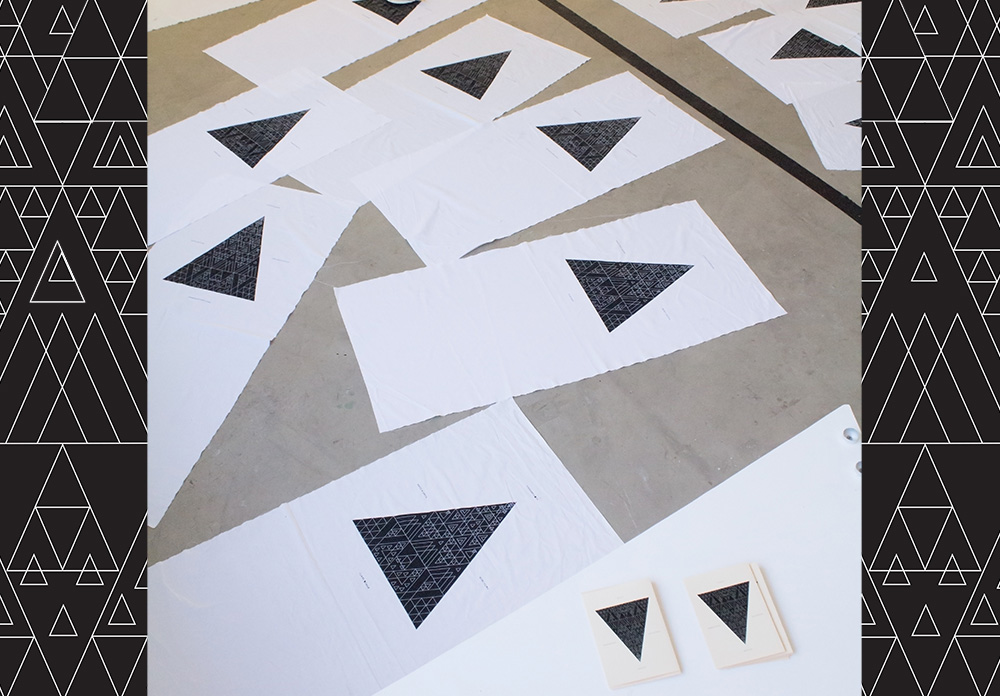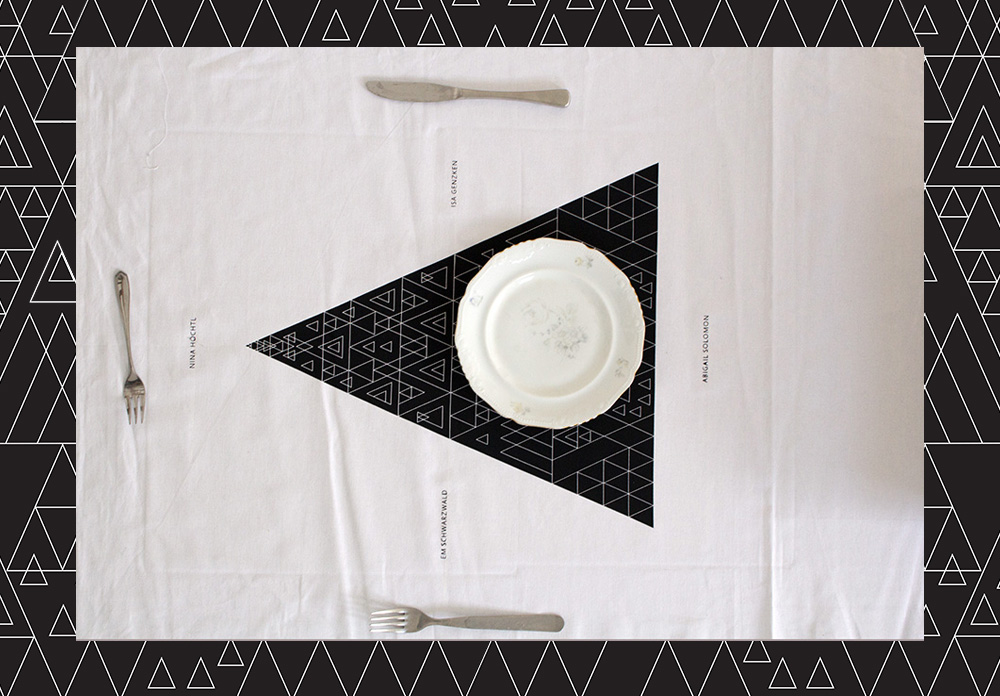A Dinner-Party
Reenactment „The Dinner Party“ von Judy Chicago
50 Teppiche
200 Namen
unendliche viele Dreiecke
realisiert im Rahmen des Jahresprogramms der VBKÖ zum Thema Freundinnenschaft.
Öffnungszeiten:
von Mittwoch den 15.10- Donnerstag den 13.11. 2014
Mittwoch 15 -19.30 Uhr
Donnerstag von 15 -19.30 Uhr
Samstag von 15 -19.30 Uhr
——————————————————————————————-
A TOAST TO OUR HISTORIES
A TOAST TO OUR FELLOW SISTERS & HEROINES
A TOAST TO OUR FUTURE
“What we have to do now, then, Sir,
is to lay your request before the daughters of educated men and to ask them to help you to prevent war,
not by advising their brothers how they shall protect culture and intellectual liberty,
but simply by reading and writing their own tongue in such a way as to protect those rather abstract goddesses themselves.”
Virginia Woolf, Three Guineas
so here we are, hosting a dinner-party, toasting to our friends, heroines, lovers and supporters.
a come-together in the spirit of judy chicago,
a strengthening ritual on magic carpets,
encouraging a big loud messy dinner conversation,
about the past, the now and the future,
embodying a living critical glossary of feminisms.
because yes, there is not one feminism, but many.
but lets begin with THE DINNER PARTY.
the art installation by judy chicago, depicting place settings for 39 mythical and historical famous women around a triangular table.
a further 999 women are honored by their names on the floor tiles.
produced from 1974 to 1979 as a collaboration with the help of many hands and brains, first exhibited in 1979.
to, as judy said: “end the ongoing cycle of omission in which women were written out of the historical record”.
thank you judy.
as for us:
we don’t have a table
we don’t have a tablecloth
we will sit on the ground
eat and chat
commemorate and chant
on magical carpets
out of the darkness
COMMEMORATION
so, whom and what are we commemorating?
our histories, the unruly knowledges of our ancestors and foresisters, their struggles and achievements, to build collective consciousness, to remember that we do not struggle independently.
with an experimental chanting exercise we are going to evoke the free thinking spirits of emma goldman and gerda lerner, kathy acker and virginia woolf, kathleen hannah, kurt cobain and beyonce.
and of course baba yaga, who gave magic carpets to fools and was described on wikipedia as “a many-faceted figure, capable of inspiring researchers to see her as a cloud, moon, death, winter, snake, bird, pelican or earth goddess, totemic matriarchal ancestress, female initiator, phallic mother, or archetypal image”, so just about everything we want to be.
MAGIC CARPET
baba yaga gave one to ivan the fool and when we believe the author of “the secret history of flying carpets”, those magic carpets were historically mainly used by thieves and madmen.
which makes them somehow the oriental male equivalent to the flying brooms used by witches.
we give you magic carpets to float through time and space, to the fractal dimension of a collective history of sunken sisterhoods.
PRAYER RUG
the form and design of our magic carpets were inspired by the traditional prayer rug.
it has a strong symbolic meaning and is taken care of in a holy manner.
the prayer mat is traditionally woven with a rectangular design, made asymmetrical by the niche at the head end.
the decorations are not only important but also have a deep sense of value in the design of the prayer rug.
within the rectangle, where one usually finds images of islamic symbols and architecture ours have a sierpinski triangle with four names.
four names,
four lives,
four seasons,
four zones,
for chapters,
four stones.
TRIANGLE
the triangle is a basic geometric shape, a polygon with three edges and three vertices.
our triangle is a slightly modified sierpinski triangle.
a fractal and attractive fixed set with the overall shape of a triangle, subdivided recursively into smaller triangles.
it is a mathematically generated pattern that can be reproducible at any magnification or reduction.
it is named after the polish mathematician wacław sierpiński, but appeared as a decorative pattern many centuries prior to the work of sierpiński.
our triangle is not equilateral but an isosceles triangle which means that two sides are equal in length.
the equal sides are called legs and the third side is called the base.
so what we have here is a endlessly reproducible base with legs.
a triangle that is good to walk and good to talk.
having a triangular conversation contains thesis, antithesis and synthesis.
THE BLACK TRIANGLE
the black triangle was a badge used in nazi concentration camps to mark prisoners as “asocial” or “arbeitsscheu” (work-shy).
it was later adopted as a lesbian and feminist symbol of pride and solidarity, on the assumption that the nazis included lesbians in the “asocial” category.
more recently it has been adopted by UK disabled people’s organisations responding to increasing press allegations that disabled benefit recipients are workshy.
also triangles, black or not, are sturdy;
while a rectangle can collapse into a parallelogram from pressure to one of its points,
triangles have a natural strength which supports structures against lateral pressures.
a triangle will not change shape unless its sides are bent or extended or broken or if its joints break;
in essence,
each of the three sides supports the other two.
thats how we like it.
SISTERS IN CRIME
SISTERS IN TIME
SISTERS IN RHYME
come together
right now
to renew your strength
to take a bow
sit down
sit in
sit on
the triangles of sisterhood.
sit with,
the spirits of our heroines,
fierce foresisters,
forgotten female generations,
and their kick ass creations.
feel the old vibrations,
build new relations,
enjoy the sensations,
celebrate your foundations.
and AFTER THE DINNER
is before the EXHIBITION
so what will remain?
a landscape of magic carpets,
wavescapes of women,
first wave women,
second wave women,
third wave women,
thousandth wave people,
who are riding together,
the waves of the stormy seas of feminism.
THE WAVES
THE FIRST WAVE:
the first wave of feminism between the late 19th century and the early 20th centuries emerged with the changing scope of global politics and rising urban industrialism.
the main goals of this wave were to create more opportunities for women in the public sphere and to gain suffrage.
THE SECOND WAVE:
the second wave of feminism took place from the 1960s through the mid 1990s, igniting with anti-war movements and the civil rights movements brought on by the growing number of minority groups.
the main focus of this movement was to gain just sexuality and reproductive rights, in addition to trying to pass the equal rights amendment to the constitution, which guarantees social equality regardless of sex.
THE THIRD WAVE:
the third wave of feminism focuses on post-modern thinking.
topics like universal womanhood, body image, gender, sexuality and heteronormativity are applied to the whole of women’s roles, not only in today’s society, but also the historical actions that evolved into women’s status today.
this status is persistently challenged by this third wave of feminism to help empower women.
THE THOUSANDTH WAVE:
is what we will make of it.
because the fight is not over yet.
or to put it with dr. gerda lerner:
”For 4,000 years, men have defined culture by looking at the activities of other men.
The minute we started questioning it, the first question was,
‘Well, when are you going to stop separating yourself out and mainstream?’
Give us another 4,000 years,” she said, ”and we’ll talk about mainstreaming.”
http://www.temple.edu/tempress/authors/1635_qa3.html
———————-
Gestaltung: Esther Straganz
Mitarbeit: Anne Steinhagen, Claudia Hanslmeier, Chloe Seon
Video: Anne Steinhagen
Keramiken: Veronika Dirnhofer
Text: Elke Auer
VBKÖ 2014
A Dinner-Party
Reenactment „The Dinner Party“ von Judy Chicago
50 Teppiche
200 Namen
unendliche viele Dreiecke
realisiert im Rahmen des Jahresprogramms der VBKÖ zum Thema Freundinnenschaft.





Comments are closed.